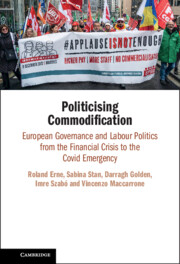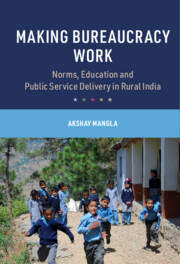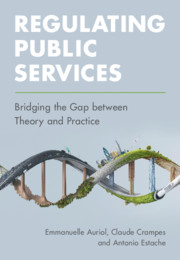Refine search
Actions for selected content:
43 results

Politicizing Business
- How Firms Are Made to Serve the Party-State in China
-
- Published online:
- 29 September 2025
- Print publication:
- 25 September 2025
Joining forces or going solo? The political and economic dynamics of intermunicipal cooperation
-
- Journal:
- Journal of Public Policy , First View
- Published online by Cambridge University Press:
- 02 September 2025, pp. 1-27
-
- Article
-
- You have access
- Open access
- HTML
- Export citation
The epidemiological transition in Macondo, 1918–1998
-
- Journal:
- Revista de Historia Economica - Journal of Iberian and Latin American Economic History / Volume 43 / Issue 1 / March 2025
- Published online by Cambridge University Press:
- 27 May 2025, pp. 63-78
- Print publication:
- March 2025
-
- Article
-
- You have access
- Open access
- HTML
- Export citation
Socialism, Democracy, Bureaucracy, and Umbrella Organizations
-
- Journal:
- International Labor and Working-Class History / Volume 106 / October 2024
- Published online by Cambridge University Press:
- 11 October 2024, pp. 439-449
-
- Article
-
- You have access
- Open access
- HTML
- Export citation
13 - The Policy Orientation of the EU’s Post-Covid NEG Regime and Its Discontents
- from Part IV - Comparative Analysis and Post-Pandemic Developments
-
- Book:
- Politicising Commodification
- Published online:
- 30 May 2024
- Print publication:
- 06 June 2024, pp 323-352
-
- Chapter
-
- You have access
- Open access
- HTML
- Export citation
7 - EU Governance of Public Services and Its Discontents
- from Part II - EU Economic Governance in Two Policy Areas
-
- Book:
- Politicising Commodification
- Published online:
- 30 May 2024
- Print publication:
- 06 June 2024, pp 132-164
-
- Chapter
-
- You have access
- Open access
- HTML
- Export citation
4 - How to Assess the Policy Orientation of the EU’s NEG Prescriptions?
- from Part I - Analytical Framework
-
- Book:
- Politicising Commodification
- Published online:
- 30 May 2024
- Print publication:
- 06 June 2024, pp 53-72
-
- Chapter
-
- You have access
- Open access
- HTML
- Export citation

Politicising Commodification
- European Governance and Labour Politics from the Financial Crisis to the Covid Emergency
-
- Published online:
- 30 May 2024
- Print publication:
- 06 June 2024
-
- Book
-
- You have access
- Open access
- Export citation
18 - Public services as conversion factors
- from Part III - Social Choice and Capabilities in Action
-
-
- Book:
- Social Choice, Agency, Inclusiveness and Capabilities
- Published online:
- 28 March 2024
- Print publication:
- 14 March 2024, pp 401-422
-
- Chapter
- Export citation
Remittance dependence, support for taxation and quality of public services in Africa
-
- Journal:
- Journal of Institutional Economics / Volume 20 / 2024
- Published online by Cambridge University Press:
- 15 December 2023, e7
-
- Article
- Export citation
A Hidden Cost: Estimating the Public Service Cost of Poverty in Ireland
-
- Journal:
- Social Policy and Society / Volume 24 / Issue 3 / July 2025
- Published online by Cambridge University Press:
- 11 December 2023, pp. 415-430
- Print publication:
- July 2025
-
- Article
-
- You have access
- Open access
- HTML
- Export citation
Administrative Literacy in the Digital Welfare State: Migrants Navigating Access to Public Services in Finland – ERRATUM
-
- Journal:
- Social Policy and Society / Volume 23 / Issue 4 / October 2024
- Published online by Cambridge University Press:
- 21 March 2023, p. 922
- Print publication:
- October 2024
-
- Article
-
- You have access
- Open access
- HTML
- Export citation
Administrative Literacy in the Digital Welfare State: Migrants Navigating Access to Public Services in Finland
-
- Journal:
- Social Policy and Society / Volume 23 / Issue 4 / October 2024
- Published online by Cambridge University Press:
- 23 January 2023, pp. 908-921
- Print publication:
- October 2024
-
- Article
-
- You have access
- Open access
- HTML
- Export citation
1 - Introduction
- from Part I - Introduction, Puzzles and Theory
-
- Book:
- Making Bureaucracy Work
- Published online:
- 18 November 2022
- Print publication:
- 01 December 2022, pp 3-33
-
- Chapter
- Export citation
2 - Bureaucratic Norms
- from Part I - Introduction, Puzzles and Theory
-
- Book:
- Making Bureaucracy Work
- Published online:
- 18 November 2022
- Print publication:
- 01 December 2022, pp 34-85
-
- Chapter
- Export citation

Making Bureaucracy Work
- Norms, Education and Public Service Delivery in Rural India
-
- Published online:
- 18 November 2022
- Print publication:
- 01 December 2022

The Hidden Tier of Social Services
- Frontline Workers' Provision of Informal Resources in the Public, Nonprofit, and Private Sectors
-
- Published online:
- 01 August 2022
- Print publication:
- 18 August 2022
-
- Element
- Export citation
403 U.S. 217Supreme Court of the United States
- from Part III - Property and Space
-
- Book:
- Critical Race Judgments
- Published online:
- 22 April 2022
- Print publication:
- 21 April 2022, pp 337-346
-
- Chapter
- Export citation

Regulating Public Services
- Bridging the Gap between Theory and Practice
-
- Published online:
- 27 January 2022
- Print publication:
- 21 October 2021
4.4 - Strength-Based Approaches to Addiction Recovery and Desistance from Crime
- from Part IV - Interventions
-
-
- Book:
- The Cambridge Handbook of Forensic Psychology
- Published online:
- 02 December 2021
- Print publication:
- 09 December 2021, pp 552-568
-
- Chapter
- Export citation
